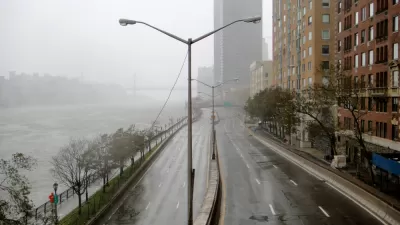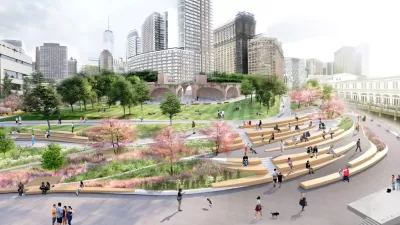Tree-huggers many of them are not, but there's consensus among Long Island developers that storm resilience is an investment worth making.

The unpleasant memory of Hurricane Sandy is bound to be at the top of Long Island developers' minds right about now. Here, Maura McDermott looks at how builders are handling the very real risk of future floods.
"'In a post-superstorm Sandy Long Island, there is a heightened awareness of where the high-risk flood zones are,' said Kyle Strober, executive director of the Association for a Better Long Island, a builders' trade group. 'The 100-year flood storms are happening every 10 years now, and that means only the very forgetful or the high-stakes gamblers are building on the ground level today.'"
Under local and state law, McDermott writes, "developers are required to protect buildings in high-risk flood zones by constructing strong foundations, elevating buildings and electrical systems and using storm-resistant materials, among other measures. But developers say they are going beyond those requirements."
For some, the risk from storms takes precedence over politics. "'The last person you're going to talk about being a tree-hugger is me,' [RXR Realty senior Vice President Joe Graziose] said. 'This is all about infrastructure. At the end of the day, you want to build something that's going to last a long time.'"
FULL STORY: LI developers spend millions to protect from future storms

Maui's Vacation Rental Debate Turns Ugly
Verbal attacks, misinformation campaigns and fistfights plague a high-stakes debate to convert thousands of vacation rentals into long-term housing.

Planetizen Federal Action Tracker
A weekly monitor of how Trump’s orders and actions are impacting planners and planning in America.

In Urban Planning, AI Prompting Could be the New Design Thinking
Creativity has long been key to great urban design. What if we see AI as our new creative partner?

Florida Seniors Face Rising Homelessness Risk
High housing costs are pushing more seniors, many of them on a fixed income, into homelessness.

Massachusetts Budget Helps Close MBTA Budget Gap
The budget signed by Gov. Maura Healey includes $470 million in MBTA funding for the next fiscal year.

Milwaukee Launches Vision Zero Plan
Seven years after the city signed its Complete Streets Policy, the city is doubling down on its efforts to eliminate traffic deaths.
Urban Design for Planners 1: Software Tools
This six-course series explores essential urban design concepts using open source software and equips planners with the tools they need to participate fully in the urban design process.
Planning for Universal Design
Learn the tools for implementing Universal Design in planning regulations.
Gallatin County Department of Planning & Community Development
Heyer Gruel & Associates PA
JM Goldson LLC
City of Camden Redevelopment Agency
City of Astoria
Transportation Research & Education Center (TREC) at Portland State University
Jefferson Parish Government
Camden Redevelopment Agency
City of Claremont





























